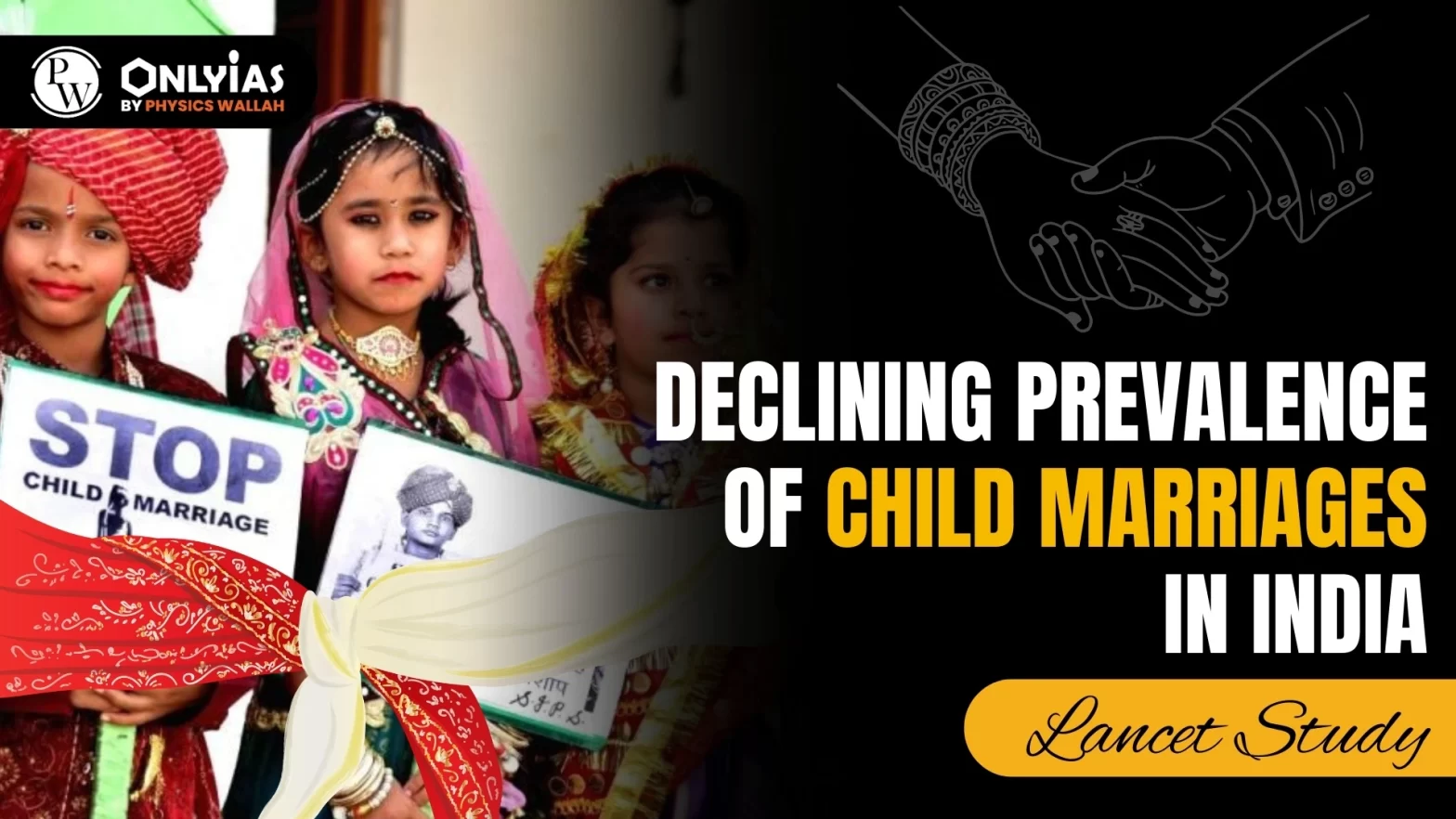Context: This article is based on an Editorial “One in 5 girls in India still married below legal age, finds new study” which was published in the Indian Express. Recently, a new study has been published by the Lancet Global Health which mentions that in India one in five girls and nearly one in six boys are still married below the legal age of marriage (18 years for girls and 21 years for boys).
Lancet Report on Child marriages in India: Key Findings
- Decline in the National Rate of Child Marriage: There have been declines in child marriage during the last three decades. However, there is evidence of stagnation.
- The largest reduction in child marriage occurred between 2006 and 2016.
- Child marriage declined considerably during the 1993–2021 for girls (49.4% in 1993 to 22.3% in 2021) and 2006–2021 for boys (7.1% in 2006 to 2.2% in 2021).
- About the number of Child Marriage in Girls: All states, except Manipur, experienced a decline in the prevalence of girl child marriage between 1993 and 2021.
- The rise in child marriage in girls was observed in Manipur and Tripura, being greater than during any previous period between 2016 and 2021.
- Existence of Variability at the Sub-National Level: Researchers have observed that substantial variability of the rate of decline of child marriage at the sub-national level exists.
- States with burden of Child Marriages:
- For Girls: Bihar (16·7%), West Bengal (15·2%), Uttar Pradesh (12·5%), and Maharashtra (8·2%).
- For Boys: Gujarat (29%), Bihar (16·5%), West Bengal (12.9%), and Uttar Pradesh (8.2%).
- States with Burden and Prevalence:
- For Child Marriage: In 2021, Uttar Pradesh had a relatively low prevalence but high burden for both girls and boys, while Tripura had a high prevalence but low burden.
- For Child Marriage in Boys: Maharashtra had a high burden but low prevalence, while Manipur has a high prevalence but a fairly low burden.
Concerns Related to Child Marriages in India
- Violation of Rights: Child marriages violate girls’ human rights such as Right to Education, Right to Protection from Mental or Physical Abuse including Rape and Sexual Exploitation.
- Against Gender Equality: Child marriages for females results in the male-dependencies and impacts the vision of gender equality.
- Impact on Future Generation: Child marriages lead to teenage pregnancy as they are unaware about future planning, that impacts the future generation.
- Impact on Economy: Child marriage negatively affects as girls and boys married as children more likely lack the skills, knowledge and job opportunities.
Government Measures to Prevent Child Marriages
- The Child Marriage Restraint (Amendment) Act, 1978: It set the legal marriage age for males and females as 18 and 21, respectively.
- Compulsory Registration of Marriages Act, 2006: All marriages in India must be registered as of the year 2006.
- The Sabla Programme of Women and Child Ministry: The adolescent girls in the age group of 11 to 18 years are imparted training about the legal rights of women, including the Prohibition of Child Marriage Act, 2006.
- Prohibition of Child Marriage Act, 2006: It defines a child as a male below 21 years and a female as below 18 years. It also provides for the appointment of Child Marriage Prohibition Officer, who was imparted with a duty to prevent child marriages and spread awareness.
- The Protection of Children from Sexual Offenses (POCSO) Act, 2012: Sexual contact with a minor is considered rape under the POCSO Act.
- Availability of Helplines: The government has introduced a CHILDLINE (code 1098), a 24X7 telephone emergency outreach service for children in crisis.
- The National Commission for Protection of Child Rights (NCPCR): It undertakes various activities and programmes on the issue of child marriages and related matters.
Also Read: Age Of Consent Under The POCSO Act
Way Forward to End Child Marriages in India
- Strengthening of Policy: There is a need for strengthening of national and state-level policy to eliminate child marriage by 2030.
- A Multi Pronged Approach: Better education, public infrastructure facilities, raising social awareness, elimination of inequalities, programmes, strong laws and their strict enforcement in a transparent manner is required.
- Incorporation of Best Practices: The recommendations of the Shivraj Patil Committee report 2011 have helped bring down the child marriages in Karnataka and it can be incorporated in other states too.
Conclusion:
The Lancet study shows that although there has been progress in reducing child marriages in India, there are still problems and differences between regions. It emphasizes the need for stronger rules and actions to completely stop child marriages by 2030.
![]() 21 Dec 2023
21 Dec 2023

